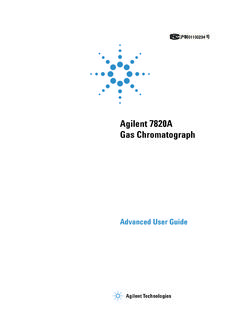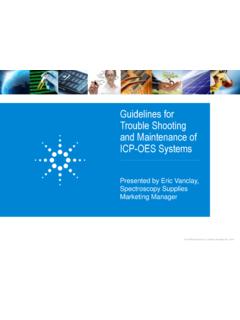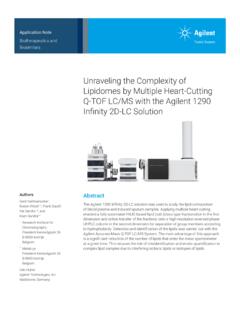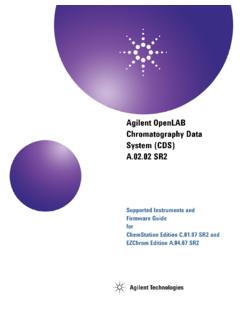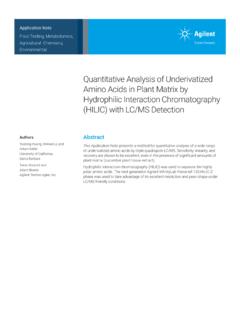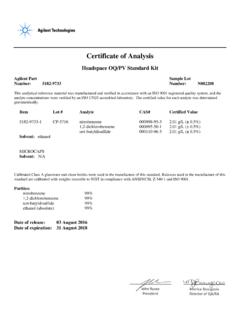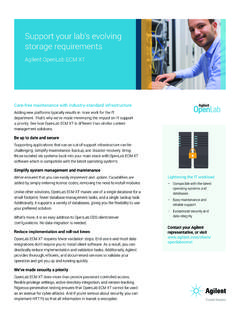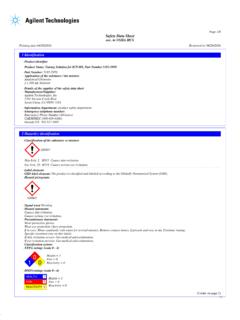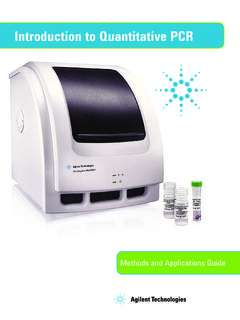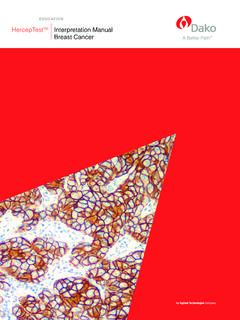Transcription of Analysis of Extractables & Leachables in Pharmaceutical ...
1 Analysis of Extractables & Leachables in Pharmaceutical Products Regulatory & Analytical Aspects Andreas Tei Pharmaceutical Segment Manager Agilent Technologies October 2015. Topics Section I. General Aspects and Regulatory Background Introduction Why Worry About Extractables & Leachables (E&L) ? Guidelines Principles of an E&L Study Inorganic Impurities In Pharmaceutical Products Section II. Analytical Approaches to Determining E&L compounds Analytical Technologies and Workflows Elemental Volatile and semi-volatile organics by GC-MS. Non-volatile organics by LC-MS. Compliance Road Show E/L 2015. 2. Introduction Drug Containers And Modern Drug Delivery Systems Drug containers and modern drug delivery systems meant to protect a drug from environmental contamination but they are actually themselves a source of contamination Compliance Road Show E/L 2015.
2 3. Plastic Materials: Source of Contamination Sources of Extractables are plastic and elastomeric components (monomers, polymeric initiators, plastizicers, etc.) ink and adhesives (label) and degradation products (processing, storage, sterilization). Cindy Zweiben, Pfizer, Inc., characterization of Extractables and Leachable in Parenteral Drug Products Compliance Road Show E/L 2015. 4. Harmful Compounds Identified as Extractable/Leachable Vulcanizing Azo Dyes Agents Antioxidants Toxic Elements Phthalate (Hg, Cd, Pb, s As, Cr, Tl, Os, Ba). Silicone Oils Lubricant Monomer s, Slip s, Dimers, Agents, Oligomers Fatty Acids and PAHs Nitrosamines Esters Wide variety of Chemical Classes, Polarity, Molecular Weights Impacts which separation method to use, Column and Ionization Method, GC, LC or ?
3 Compliance Road Show E/L 2015. 5. Defining Extractables , Leachables , Migrants Extractable Chemical compounds that can be extracted out of packaging component Analyze packaging component at Extractables Leachables High-temperatures: to obtain the worst case (Packaging) (Drug) leachable profile Solvent extraction: polar and non-polar solvent to mimic similar properties as drug Potential Actual product Compound Compound Migration Migration Leachable Chemical compounds from packaging component that leach into the drug product Extractables Extractables Analyze drug product at Normal conditions Leachables / Stimulate extended storage conditions Migrants Leachables Migrants Leachables are New Leachables may be Crossed a physical barrier primary packaging often a subset of identified from secondary and tertiary packaging, Extractables which have been not accumulating in the drug product observed as Extractables Compliance Road Show E/L 2015.
4 6. Why Worry about Extractables / Leachables ? 2014: FDA Drug Recalls Surges over 836 in 2014! 2014: FDA data shows the last two years have seen almost as many recalls (2,061) as the previous nine years combined (2,217) and that's only counting the first seven months of 2014. Ref: August 2014. August 2015: FDA warns against use of Becton-Dickinson (BD) 3 ml and 5 ml Syringes: Special Concerns about E/L Effects on Biologics Leachables may affect protein products in the following ways - Oxidation - Unfolding - Aggregation - Increase in particulates - Formation of clipped variants - Formation of Protein Adducts - Post translational events during fermentation (glycosylation). - Altered protein translation Ref: Ingrid Markovic, CBER Presentation USP/PQRI E/L Workshop April 2014.
5 Compliance Road Show E/L 2015. 8. FDA 21 CFR (a) statement (current as of April 2015). FDA 21 CFR (a) statement (current as of April 2015). (a) Drug product containers and closures shall not be reactive, additive, or absorptive so as to alter the safety, identity, strength, quality, or purity of the drug beyond the official or established requirements. (d) Standards or specifications, methods of testing, and, where indicated, methods of cleaning, sterilizing, and processing to remove pyrogenic properties shall be written and followed for drug product containers and closures.. Compliance Road Show E/L 2015. 9. Guidelines Delivered By Pharma Industry Expert Working Groups PQRI (Product Quality Research Institute) is a working group established to developed regulatory guidance for Extractable/Leachable Analysis , which is also recognized by the FDA.
6 Compliance Road Show E/L 2015. 10. PQRI guidance for OINDP. (Orally inhaled and nasal drug products). PQRI issued guidance for OINDP: Safety thresholds and best practices for Extractables and Leachables in orally inhaled and nasal drug products (OINDP) also Applicable to parenteral and injectable products (PODP). PQRI established safety thresholds for Leachables : Safety Concern Threshold (SCT) g/day patient exposure which species represent no risk Qualification Threshold (QT) 5 g/day patient exposure which a leachable is not considered for safety qualification. Lower threshold applies to PAH's, nitrosamines, and 2-mercaptobenzothiazole Estimated Analytical Evaluation Threshold (AET) ( g/g) = (SCT x total labeled doses) / (Doses per day x mass of component).
7 Best practices include controlled extraction studies and Leachables studies. Compliance Road Show E/L 2015. 11. USP Chapters dealing with E&L. Ref: Denise R. Jenke, Daniel L. Norwood, and Desmond G Hunt Compliance Road Show E/L 2015. 12. Inorganic Impurities New USP general chapters <232> and <233> for elemental impurities Reagents, Ligands, Catalysts Manufacturing Aids Inks and Dyes USP<232> defines the analyte limits, while USP<233> defines sample preparation options including closed vessel microwave digestion, and recommends the use of modern instrumentation, such as multi-element ICP-MS and ICP-OES techniques. Analytical equipment qualification under USP<233> is based on performance testing, and includes requirements to demonstrate accuracy, repeatability, and the unequivocal identification of analytes.
8 Compliance Road Show E/L 2015. 13. Analytical Requirements for Inorganic Impurities Conc Limits ( g/g) Conc Limits ( g/g) Conc Limits ( g/g) ICP-MS ICP - OES. for Oral Drug with for Parenteral with for Inhalation with Max Daily Dose of Max Daily Dose of Max Daily Dose of 10g/day 10g/day 10g/day Element Cd Pb 2. As 1. Hg Ir 10 1 2. Os 10 1 5. Pd 10 1 4. Pt 10 1 Rh 10 1 1. Ru 10 1 2. Cr NA NA Mo 10 1 1 Ni 50 5 1. V 10 1 3 Cu 100 10 10 All elements can be determined at sub-ppt DLs using 7900 ICP-MS (mostly 3 or 4. orders lower than ICP-OES). Compliance Road Show E/L 2015. Page 14. 14. Analytical Technologies for E & L Analysis No single analytical method detects all extractable. Potential Analytical Techniques Depending Techniques used should be compound specific.
9 On Polarity and Molecular Weight Headspace GC/MSD volatile organic compound, high migration potential species ( inks, adhesives, glue, processing solvent). SEC GFC GC-MS semi-volatile organic compounds, residual monomers, antioxidant, plasticizers, antistatic Molecular Weight agents, clarifying agents, preservatives, PAHs, slip HPLC agents SFC CE LC-UV-MS non-volatile organic compounds, large oligomers, large antioxidants, thermally labile compounds Ion chromatography Bromide, chloride, fluoride GC IC in elastomers ICP-MS metals from aluminum canister, glass Chemiluminescence Detection nitrosamines Polarity CE: Capillary electrophoresis GFC: Gel-filtration chromatography Most Agilent provides a wide range of SEC: Size-exclusion chromatography products: IC: Ion chromatography GC/MS, GC/QQQ, GC/QTOF, HPLC, LC/MS, ICP/MS.
10 Compliance Road Show E/L 2015. 15. Polling Questions Question #1. What is your specific analytical need for an E&L Analysis ? Answers #1 QA/QC for small molecule drug products #2 QA/QC for bio- Pharmaceutical drug products #3 QA/QC for packaging materials #4 QA/QC in CMOs #5 CROs #6 Other Question #2. How strong is the risk for one of your products getting recalled due to a contamination with harmful E&Ls? Answers #1 low, everything under control #2 medium #3 high Compliance Road Show E/L 2015. 16. Key Principles of an E&L Study Evaluating The Interactions Between Packaging Material And 1 The Pharmaceutical Formulation And The Resulting Risks Extractable Study: Applying Different Extraction Procedures 2 And Different Analytical Technologies Toxicological Assessment: Defining Threshold Levels For The 3 Extracted Compounds Leachable Study: Detection, Identification and Quantitation Of 4 Leachables Within The Formulation Compliance Road Show E/L 2015.
